The Lebanon Silver Mine
The Mine Portal
These photos show the area just inside the portal (or entrance) to the Lebanon silver mine. The photos also show two other things. First, the top photo shows the result of a process known as spiling. When making a portal into a mine, rails would be jacked (or sledgehammered) into a mountain side. Then the rock and dirt were cleaned out underneath the rails. As the rock was removed, 12" by 12" timbers (bottom photo) were set in place. Finally, 3" planks were put on the sides (ribs).
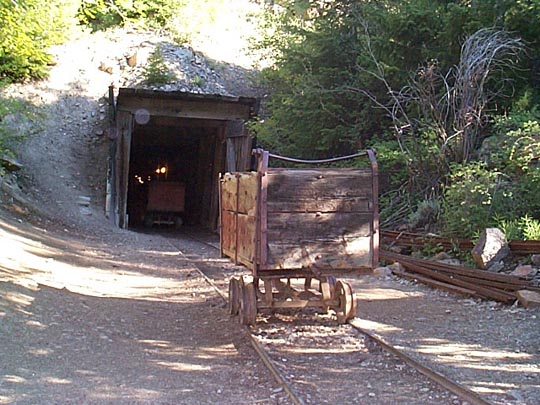
Photo: N/A
More About This Topic
The Lebanon Mine's portal required some timbering. The mine as a whole, though, needed very little timbering to hold up the roof or sides of the tunnels. That is so because most of the mine is drilled through Silver Plume granite. This granite is very dense and uniform. A mine requiring little timbering is called a baldheaded or baldfaced mine.
The ore cars seen in this photo are of a now standard size. The track was 24" gauge and each car could carry a ton of ore. A previous photo of the mine's portal, however, shows that the tracks in the Lebanon Mine were not always this gauge. The mine used an unusual 13" gauge track and smaller ore cars. In fact, 18" was the standard gauge at the time. Even so, the smaller gauge allowed the Lebanon miners to move their ore cars more easily in cramped quarters.
The "Lunch Room"
Miners needed a place to get together for lunch during their ten hour shifts underground. Most mines of any size had a "lunch room." The actual lunch room in this mine was probably not this close to the portal. (The barrier at the end of the lunch room in the photo is only 464 feet from the portal.) The lunch room is also 340 feet below the surface of the mountain above. This adit (tunnel) went back 1200 feet into the mountain. It has been reopened to about 900 feet.
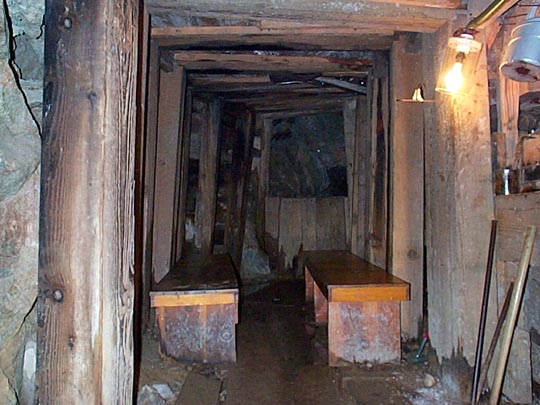
Photo: N/A
More About This Topic
Mine historian Lee Behrens holds a double jack (sledge) hammer. The double jack hammer weighed eight pounds. A single jack hammer weighed four pounds. Two miners worked together when double jacking. One miner worked by himself when single jacking. In both cases, the miners were drilling holes in the mine. The hammers were used to hit steel drills. One drill was good for boring about six inches of rock. The resulting holes were filled with dynamite.
When the Lebanon Mine operated in the late 1800s, there was no electricity in the mine. Just beyond the electric light in the photo is a candlestick. The candle holder is stuck into the timber of the lunch room. Each miner was given three candles, about enough for one ten hour shift. The metal object to the right in the photo is a miner's lunch bucket. This is also known as a pie pan and Cornishman's lunch bucket. Cornish miners made up about 60 percent of all miners working in Rocky Mountain mines.
In The Tunnels
The photo on the right shows a part of the Lebanon "adit." An adit differs from a tunnel in that the former has only one portal. Miners drilled an adit to get to the veins of silver ore. Veins of ore were usually discovered on the surface. The angles of the vein were then determined as best as possible. An adit is then drilled at the base of the mountain. The miners hoped the adit will run into the vein inside the mountain. The Lebanon adit ran through ten different veins of silver ore.

Photo: N/A
More About This Topic
The photo on the right shows another part of the Lebanon "adit." The angle of vision is toward the mine's entrance. The mine portal is the light spot in the left center of the photo. Notice the track on the bottom and the water running down the left hand side of the track. Think, too, that the original mine adit did not have electric light in it. This mine would have been dark (even with candles), damp, and cold.
The photo on the right shows the timbered portion of the mine "adit." The mine portal is now in view. By the time the miners got here at the end of a ten-hour work shift, they would have been wet and cold. They would have been ready to be warm and dry. They would also have been in a bit of a hurry, since they had just set dynamite charges in the adit. These would explode, loosening rock. Cleaning up the rock and carting it out of the mine was the first job on every shift.
Stopes And Drifts
The photo below shows a portion of a "stope." A stope is a cut that goes upward from the mine tunnel or adit. This specific cut is part of the so-called Morning Star Lode. The Lebanon adit was drilled to find this silver ore vein. At any rate, the stope went up into the mountain about 150 feet. A steam-driven hoist (previous photo) also raised and lowered men and ore from a downward "shaft" in the Morning Star Lode. This downward cut or shaft was called a winz.
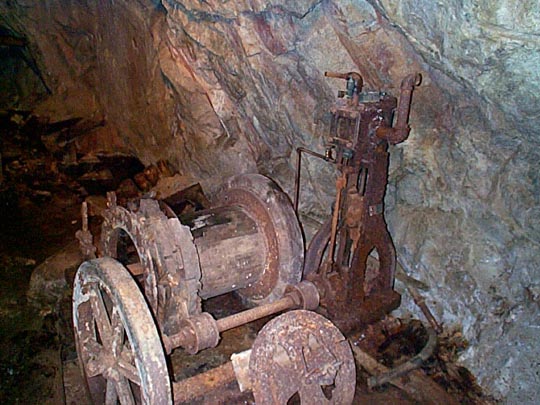
Photo: N/A
More About This Topic
This photo shows a part of a "drift." Miners drilled into the base of a mountain to find veins of ore. When miners found a vein, they cut a drift to follow the vein. The Lebanon Mine was originally cut to find two other veins. This first one was an added bonus. The reason these cuts are called drifts is that they just drift along, following the veins where ever they may go.
The photo above shows a "shaft" that goes downward. Shafts cut down are called "winzes." (Shafts cut upwards are called raises). You may be able to see that this portion of the Lebanon Mine is filled with water. There are actually two levels of the mine below the main adit. All these levels are now filled with water. They would have been filled with water when this was an operating mine without large pumps to remove water from the mine.
Change Room
The term hard rock miners used for this shack was "the dry". (Coal miners called it a change room). Miners came to work in every day clothes. They hung those clothes on pegs and changed into their mining gear. At the end of a shift, the miner changed from his wet mining clothes. Since a fire burned in the stove constantly, the miner's clothes would be dry when he came back to work the next day.
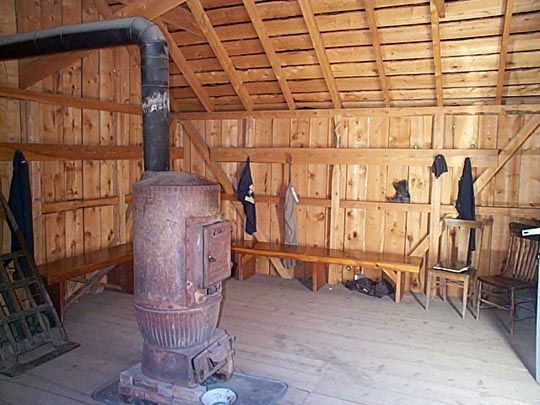
Photo: N/A
More About This Topic
Dry clothes were important items for miners. First, the Lebanon Mine is 8860 feet above sea level. There is much snow and cold weather at that elevation. Second, it was both damp and cold inside the mine. Third, the miners generally had bad lungs. Drilling in quartz or granite produces a fine silica dust. Under a microscope, these dust particles are very sharp. Over the years, this dust would make tiny cuts in a miner's lungs. Acid in the dust would start to petrify (or make very hard) the tissue in the miners' lungs.
Concern about miners' health was not the only reason there was a dry room. Miners sometime took pieces of ore when they went off shift. They would sell these to ore merchants. This practice was known as "highgrading." Since miners always felt they were underpaid, they felt they had a right to highgrade. In the mid-1870s, a laborer made $3.00 a day, a technical miner $3.50, and a blacksmith $4.00. By changing in "the dry", it was more difficult for miners to highgrading ore from the mine.
Mine Office
This building was probably the mine manager's office. (It is the only building to have a sky light). It was a place the manager could keep track of the payroll, ore production, and mill records. The furnishings are not original to the site. It has been set up with furniture thought to be appropriate for the time and place. It includes such items as desk, spittoon, leather mail pouch, ledger books, assayer's scale (an example in the office at the Hamill House) and so forth.
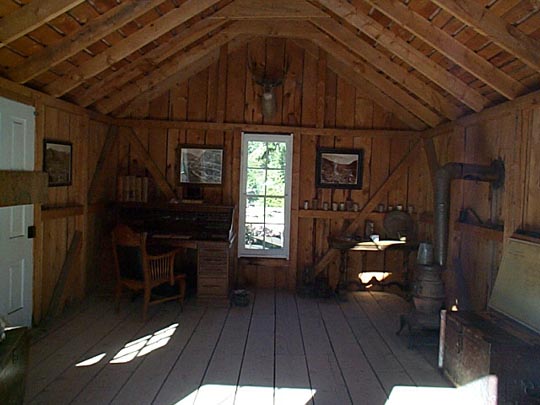
Photo: N/A
More About This Topic
The photo above shows an outside view of the mine manager's office. It is located between the dry (or change) room (just behind) and the tool shed to the left and out of sight. Note that the rails between the mine portal (to the right) and the mill (down the track toward the left) run right by the office. Notice, too that a sky light is on the roof of the mine office.
These two photos show the stove and display case in the mine office. The display case, in turn, shows silver-lead ore like the ores mined in the Lebanon. The Lebanon always had a reputation for being a mine with modest, but real, value. The silver contents of the ten veins the mine crossed varied in value. In all, the Lebanon produced ore worth about five hundred thousand dollars. At the time, an ounce of silver was worth about $1.25. The whole Clear Creek Valley produced $200 million in silver.
Tool Shed
The photo below shows the inside of the tool shed. As you might expect, mining required many different kinds of tools. These, in turn, varied depending on the time during which the mining took place. The "rifle-like" tool in the center of the photo is called a steam drifter. A drifter was used to drill holes into the face of a drift or of an adit. The vertical pipe was mounted between the back (ceiling) and floor of the mine. Using tools like these, miner could drill holes much more quickly and easily than with hand tools.
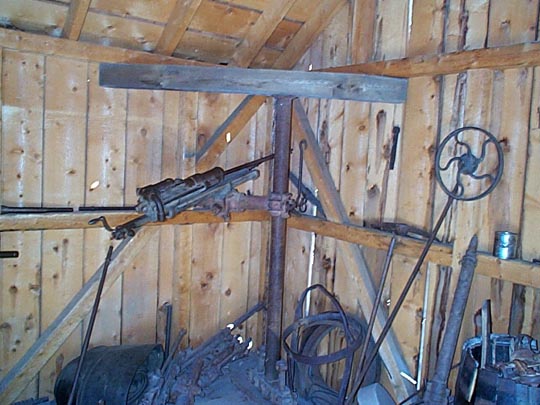
Photo: N/A
More About This Topic
This photo shows the tool shed (the left-most building), the mine office (center), and the dry shed. It also shows the ore car tracks running between the mine portal and the mill to the left. All aspects of the Lebanon Mine and Mill operation were set close together. On the right is a part of Republican mountain. This mountain contained all the veins struck by the Lebanon Mine.
Blacksmith Tools
The photo below still shows items contained in the tool shed. Many of the items in this shed were used by the blacksmith. The blacksmith, in fact, may have been the most important worker at the mine. The bellows (the reddish object with two round tan holes in it) was an important part of the blacksmith's forge. The bellows forced air into the forge to make its fire hotter. The blacksmith used the forge to heat and then sharpen drill bits.
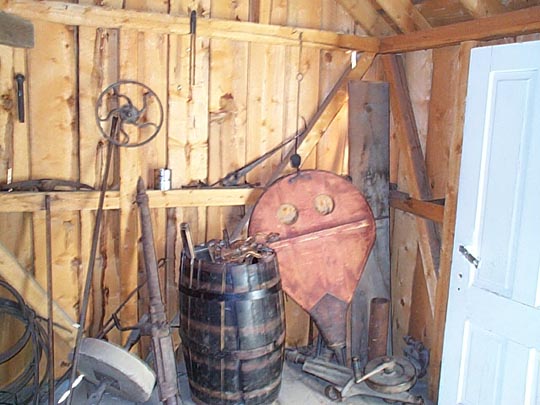
Photo: N/A
Process Of Milling Ore
The first three steps on the left side of the diagram:
Step 1: ore-bearing rock is taken to the part of the building (on the left) where ore is to be received.
Step 2: ore is shoveled on a grizzly where it is sized in a
broad sense. From here on, the ore moves as a slurry. This means it travels in water.
Step 3: ore then goes through a rock crushing machine. Ore first passes through the machine's jaws, and then is further crushed by its rollers.
The three steps in the middle of the diagram:
Step 4: ore slurry is lifted to a higher level in the mill by a bucket elevator.
Step 5: ore slurry is dumped onto sizing screens. These are rotating mesh drums, each with mesh of a different size opening.
Step 6: rock sorted by size, then passes down a wooden chute onto jigs. The jigs are shaken much like a gold pan. Lighter waste rock washes away; heavier metal-bearing rocks fall to bottom.
The last step in the ore-processing sequence:
Step 7: the remaining silver-lead concentrate is then sacked for shipment by wagon or railroad to a smelter for final refining. The Lebanon Mill, like others of the period, was crude and very inefficient by today's standards. Less than 50 percent of the lead and silver were recovered. The rest ended up on the tailings pile below the mill. Some of the tailings pile has been washed away in the one hundred plus years since the mill operated.
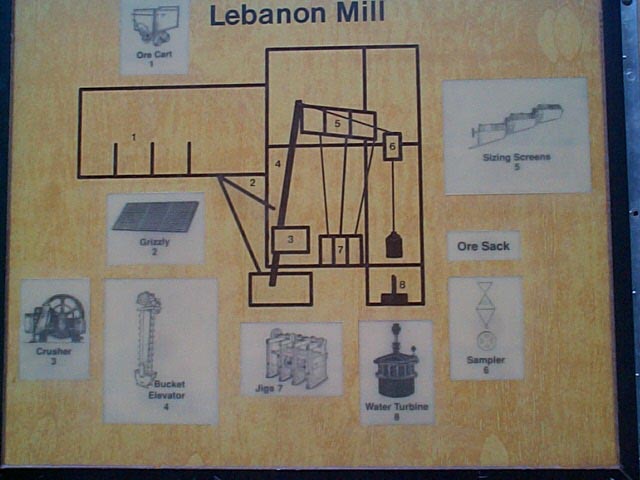
Photo: N/A
Outside The Mill
The mill is the only building that is partly original to the site. Currently the mill is not part of the tours operated by the Colorado Historical Society. The Society has future plans for this building. However, the portion of the mill building in the photo is the end closest to the mine portal. It was here that ore from the mine first arrived at the mill. A trestle with track for the ore cars once ran into this wall of the mill.
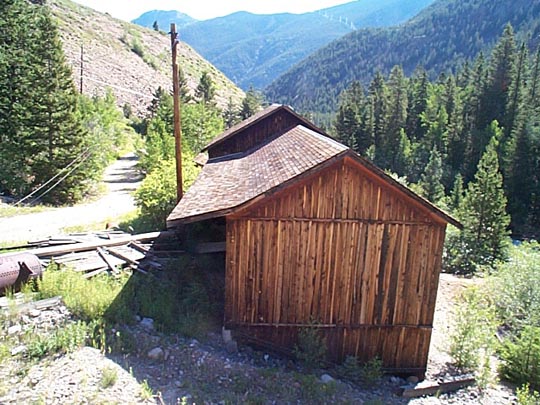
Photo: N/A
More About This Topic
The chief purpose of the mill was to dress, concentrate, and sample the ores from the mine. Dress means to clean or remove waste rock (called gangue) from ore bearing rock. Concentrate means to separate ore from its containing rock. Sample is the process of taking a portion of the ore to represent the entire bulk of ore. This was important because the Lebanon Mine often was digging in more than one vein at once. Different veins often had different proportions of silver content compared to waste rock.
Inside The Mill
This photograph shows the lower part of the Lebanon Mill. Mills, as well as mines, generally put gravity to work for the miners. The raw ore was received in the upper parts of the mill. Each successive stage proceeded down-hill. The single exception was the bucket elevator which raised the slurry. The final processed ore came out at the bottom of the mill. There, the ore was then bagged and loaded onto wagons for shipment down the mountain.
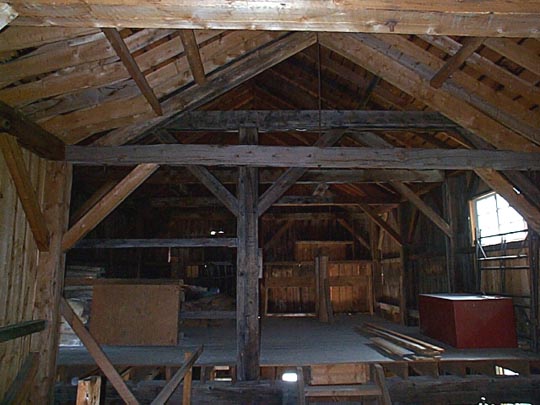
Photo: N/A
More About This Topic
The photograph shows the highest part of the mill. The photo was taken from the receiving part of the mill. You may notice that the beams shown in the photo are of different colors. The darker beams are actually original parts of the Lebanon Mill building. The lighter color beams are made of new wood, part of the reconstruction of the mill building.
Powering The Mill
The photo below shows the jaw crusher used in the Lebanon Mill. Power was provided by water power. Using a series of large belts, the water power was delivered to such machines as this crusher. The belt went around the round wheels on the right. When miners wanted power, they slipped the belt on this pulley. Gears inside the flywheel on the left moved the jaw and the rollers. Miners fed ore into the top of the device.
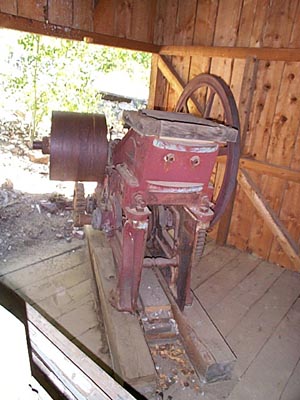
Photo: N/A
More About This Topic
The Lebanon Mill ran on water power. Clear Creek itself ran fast enough during some times of the year to power the machines. But the machines could not be placed too close to the stream. As a result, the miners built dams on Clear Creek. In the bottom part of the photo, you may see some logs. These were set in the water and then miners filled in around the logs with waste rocks. Eventually a dam was built in this fashion. The water could then be routed to power a water turbine.
- Colorado Indians Tour One
- Georgetown's Historic Houses
- Georgetown's Historic Stores
- An 1860's Farm
- An 1890's Farm
- Denver's Historic Larimer Square
- Denver's Historic Lower Downtown
- Denver's Historic 17th Street
- The Lebanon Silver Mine
- Denver's Historic Civic Center
- Denver's Historic Uptown District
- Virtual Field Trips Home

